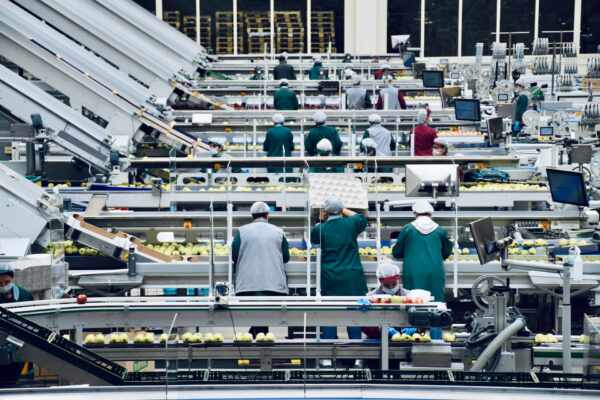In the highly regulated and competitive world of food manufacturing, maintaining high standards of hygiene and efficiency within your production processes is of utmost importance. Conveyor belt systems play a crucial role in streamlining and optimising these processes, ensuring that manufacturers can adhere to strict food safety regulations while delivering high-quality products to the market in a timely manner.
Recognising and understanding the unique challenges of food manufacturing operations is critical in making informed and effective decisions regarding conveyor belt selection. Choosing the most suitable belt type for your specific needs and regulatory requirements can contribute significantly to the overall success of your facility. With a myriad of conveyor belt types available on the market, identifying the ideal solution for your operations can be a daunting task. However, armed with the right knowledge and insights, you’ll be well-equipped to make the best choice to maximise hygiene, efficiency, and productivity within your food manufacturing processes.
In this blog post, our focus will be on exploring the essential factors to consider when choosing the most suitable conveyor belt for your food manufacturing operation. We’ll delve into the key considerations, including the types of materials and belts engineered specifically for food production environments. Additionally, we’ll discuss the importance of regular maintenance and cleaning procedures crucial for ensuring the longevity and performance of your conveyor belt system – ultimately contributing to the overall success of your facility.
1. Conveyor Belt Materials for Food Production
Perhaps the most crucial consideration when selecting a conveyor belt for your food manufacturing operations is the type of material it’s made of. Belts used in food processing must be designed to withstand demanding production environments and conform to rigorous food safety standards. The most common materials suitable for food production are:
- Food-grade PVC (Polyvinyl chloride): This is a prevalent choice for food manufacturing operations due to its flexibility, affordability, and ease of maintenance. It is resistant to oil, grease, and chemicals found in cleaning agents. It is also easily cleaned and sterilised.
- Polyurethane (PU): PU belts offer excellent resistance to abrasion, oils, fats, and chemicals. They can withstand high-pressure washer cleaning and are well-suited for production processes that involve direct food contact.
- Stainless steel: Metal belts are an excellent choice for applications that require exceptional durability, heat resistance, or a non-porous surface. Stainless steel belts are also easy to clean and sterilise, making them an attractive option for food manufacturers who prioritise hygiene.
2. Food-Specific Conveyor Belt Designs
Aside from the material composition, it’s essential to consider the belt design when selecting a conveyor belt for food manufacturing. Various designs cater to specific food production needs, such as:
- Modular plastic belts: These are versatile belts suitable for various food processing applications, including sorting, washing, and packaging. The modular design allows for easy replacement of damaged sections.
- Flat belts: These belts are ideal for selecting and transferring delicate food products without causing damage. They can be made from materials like PU or PVC.
- Cleated belts: Cleats help prevent product slippage on inclines and declines during food processing, ensuring a more reliable and efficient operation.
3. Cleaning and Maintenance: The Key to Conveyor Belt Longevity
Regardless of the material or design, effective cleaning and maintenance practices are essential to prolong the life of your conveyor belt system and maintain optimal hygiene levels. Key aspects of conveyor belt maintenance and sanitation in food manufacturing operations include:
- Regular cleaning: Schedule thorough, regular cleanings to remove accumulated dirt and debris, reducing the risk of microbial growth and cross-contamination.
- Inspection and repairs: Inspect your conveyor belts regularly for signs of wear, damage, or foreign objects that might damage the system. Address any issues as soon as possible to prevent escalation.
- Lubrication: Proper lubrication of conveyor belts ensures smooth operation and reduces wear on components, ultimately prolonging the system’s life.
4. Balancing Cost with Quality and Performance
While cost will inevitably play a role when selecting a conveyor belt, it’s crucial to balance financial considerations with the overall performance of the conveyor system. Investing in high-quality conveyor belts specifically designed for food production can yield significant returns in the form of reduced maintenance costs, improved efficiency, and reduced risk of product recalls.
Conclusion
Making the right conveyor belt selection for your food manufacturing operation can have a substantial impact on the efficiency, hygiene, and overall success of your facility. By considering factors such as the belt material, design, and maintenance requirements, you can make informed decisions that contribute to a cleaner, more efficient food production process.
If you require tailored guidance or assistance in selecting the best conveyor belt solution for your food manufacturing operation, Change Parts Pty Ltd’s team of experienced conveyor belt specialists is here to help. With years of industry experience and a comprehensive range of conveyor belt solutions, we can help you make informed decisions that maximise the efficiency and hygiene of your operations. Get in touch with us today to learn more about our services and explore our range of conveyor belts specifically designed for the food manufacturing industry.




